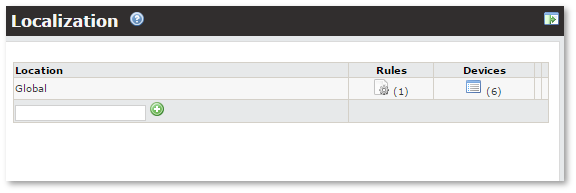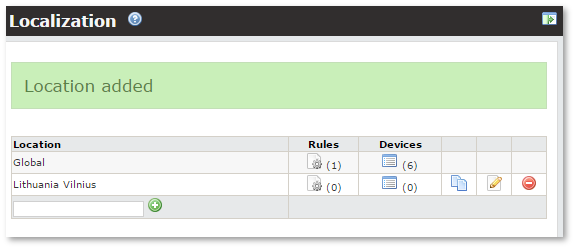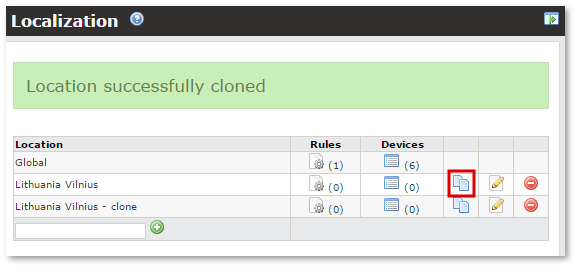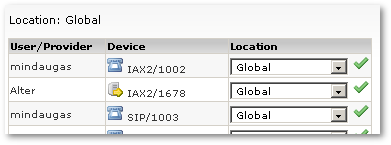Localization
Description
Localization transforms received number to E.164 format number.
The main idea of localization is: No matter how the user dials the number (destination), when localized it should be in E.164 format.
Localization has nothing in common with numbers you send to providers. It operates with numbers received from the caller.
Depending on the location of the user (or his device), it is often important to allow users to dial differently formatted numbers to reach a destination. For this purpose, each device has a field Location, which describes the physical location of the device and provides rules for how the device can dial a destination. In other words each device IS in (or belongs to) some Location where specific dialing rules apply.
Location describes where a caller IS - not where he is calling to!
By default, a device has the location 'Global'. Global rules apply to ALL devices. If a user belongs to some other location and his dialed destination has some rule for his destination, then global rules are not activated – they have a lower priority in location rules.
You can access Localization settings in SETTINGS –> Billing –> Functions –> Localization.
In the main window you can see available Locations:
At first there is only the Global location. You can't delete this location. It's the default for all devices.
You can add a new Location by entering this Location's name in the field at the bottom of the table:
Clone
Additionally you can make a copy of your current Localization rules by clicking copy icon:
Rules
In the Rules column, click the Rules icon to access Location's rules:
![]()

Destination Rules - Changes Destination number.
CallerID Rules - Changes source number.
Combined Rules - Change Destination number and Source number. Please note that both Destination and Source cells must be matched to apply Combined Rules. Special symbols * and # does not work in combined rules.
Priority of rules that are applied first:
- 1) CallerID Rules
- 2) Combined Rules
- 3) Destination Rules
note that if the match is found among "Combined Rules", then "Destination Rules" are skipped completely.
The following settings should be explained for rules:
- Name – just for informational purposes.
- Cut – what prefix should be cut from the number.
- Add – what prefix should be added to the number.
- Min Len – the minimum length of the number to which the rule is being applied.
- Max Len – the maximum length of the number to which the rule is being applied.
- Change User Tariff to this Tariff - which Tariff to apply when this rule is applied. It is used in special cases, for example here. Leave this empty in most cases.
- Change User LCR to this LCR - which LCR to apply when this rule is applied. It is used in special cases, for example here. Leave this empty in most cases.
- Route to DID – allows to route calls to DID according to localization rules.
- Change Call's owner - changes the owner of the call depending on the incoming tech prefix.
- Enter edit mode - lets you change all rules at one time.
When you have entered all the necessary values (Cut or Add can be left empty), click ![]() .
.
For example:
- The normal Lithuania MOB prefix is 3706.
- The user's device is located in Vilnius, Lithuania (displayed as "Lithuania Vilnius").
- By current Lithuanian regulations, the local customer can dial 9-digit numbers starting with 86 to reach Mobile subscribers.
To describe this situation, we create the following rule:
Rules can be enabled or disabled by clicking the ![]() icon or
icon or ![]() in the Enabled? column.
in the Enabled? column.
Now, in the main Localization window:
click on ![]() in the Devices column to access Devices in Global Location:
in the Devices column to access Devices in Global Location:
Here all Devices with a selected location are listed. Choose other locations for the selected Device and click on ![]() icon to activate this change. The device will be assigned to the selected Location.
icon to activate this change. The device will be assigned to the selected Location.
NOTE: It's possible to change a device's Location in the Device settings (SETTINGS –> Users –> Devices).
Now our device belongs to Location "Lithuania Vilnius". And if we dial a mobile number in the Lithuanian format, for example, 863042439, MOR cuts 86 (leaving 3042439) and adds 3706. The result is 37063042439, which is E.164 compatible and can be billed correctly by MOR.
NOTE: make sure that after localization your number is always E.164 compatible. Call Tracing can help you do this.
NOTE: you cannot delete rule if it is assigned to a device.
Special cases
Cut everything till Hash
With rule Cut: *# it is possible to cut everything till # (# included) in the dialed destination:
For example:
- Dialed number: 1aaaaaaaaa#37063042439
- After Localization: 37063042439
Please note that if Dialed number will be #37063042439, call will not go through, because MOR rejects destinations with # in front of it.
This function can be used in fancy MNP (Mobile Number Portability) schemes and perhaps elsewhere.
NOTE: The Add value still can be used to add any value after Cut is used on the Destination.
Cut any digits after specific prefix
Works only with Destination and Combined rules.
Cut pattern accepts "x" which indicates any digit:
Cut: 12xxx
will cut first 5 digits from number which starts with digits "12".
If there are two rules like
Cut: 12xxx
Cut: 1234x
and a number
12345
then the rule Cut: 1234x will be selected, because it matches most of the exact digits.
Example1:
If we have rule
Cut: 12xxx
Add: 99
then all following dialled numbers
1200012345
1257812345
1298712345
will be modified to
9912345
Example2:
If we have rule Cut: 123xxx78
Add: 78
then all numbers starting from 12300078 till 12399978 will be localised to start with 78
Change LCR/Tariff when CallerID is empty
To change LCR/Tariff when CallerID is empty, set following in Source Localization:
Cut: *
Min Len: 0
Max Len: 0
and then choose LCR/Tariff you want to set for calls without CallerID.
Reseller localizations
Reseller is not using admin's global localization rules. Instead now he can copy the rules and modify them according to his needs. All new created resellers have those global rules copied automatically from admin. This feature can be disabled by admin in Reseller Settings.
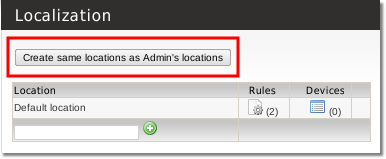
IMPORTANT: Fields "Change User Tariff to this Tariff" and "Change User LCR to this LCR" will not be copied.
"Default location" does not act as "Global location" on reseller's account. Only the rules set in the device's settings will be applied.
Route to DID
Admin and Reseller PRO users are allowed to route calls to DID according to localization rules.

Start typing the DID number and you will see all the DIDs that start with that number. If the DID you need is not there, enter more digits - only first 20 DIDs starting with that number is shown.
Change owner of call depending on incoming prefix
It is now possible to change the owner of the call depending on the incoming tech prefix.
- Open the localization menu to find the "Change Call's Owner" field.
- Enter the incoming prefix that needs to be cut in the "Cut" section.
- Afterwards, choose a user from the drop down list and the device to which the call should be assigned.
- This feature is available also for resellers.
- Admin can assign the call to ANY user on the system (even to those that do not belong to admin).
